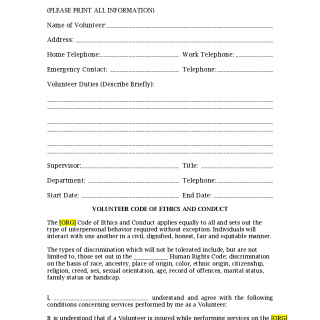Volunteer Waiver Form
A Volunteer Waiver Form is a legal document used to release an organization from liability for any injuries or damages sustained by a volunteer during their participation in an organization or program. This form is important for both the organization and the volunteer as it serves as a formal record of the waiver and can be used for legal or administrative purposes.
The Volunteer Waiver Form consists of several parts, including the organization's name and contact information, the volunteer's name and contact information, and a statement releasing the organization from liability for any injuries or damages sustained by the volunteer during their participation. The form may also include additional information such as the volunteer's duties and responsibilities and any relevant policies or regulations.
Important fields to consider when completing the Volunteer Waiver Form include the specific activities that the volunteer will be participating in, any potential risks associated with these activities, and any limitations on the waiver. It is important to ensure that the waiver is clear and specific, and that the volunteer understands and acknowledges the risks associated with their participation.
Parties involved in the Volunteer Waiver Form include the organization and the volunteer. The organization is responsible for providing the necessary documentation and outlining the terms and conditions of the waiver, while the volunteer is responsible for understanding and agreeing to these terms.
Data required when filling the form includes the volunteer's name and contact information, the specific activities that the volunteer will be participating in, and any potential risks associated with these activities. Additional documents that may need to be attached include any relevant agreements or contracts between the organization and the volunteer.
Application examples and practice and use cases for the Volunteer Waiver Form include volunteer participation in physical activities such as sports or construction projects, volunteer participation in research studies or clinical trials, or volunteer participation in events or programs that involve potential risks or hazards.
Strengths of the Volunteer Waiver Form include its ability to protect the organization from legal or administrative issues related to injuries or damages sustained by volunteers, and to ensure that volunteers understand and acknowledge the risks associated with their participation. Weaknesses may include the potential for misunderstandings or misinterpretations of the waiver, and the need for clear and respectful communication.
Related and alternative forms to the Volunteer Waiver Form include the Volunteer Agreement, which is used to establish the terms and conditions of a volunteer's participation in an organization or program, and the Volunteer Confidentiality Agreement, which is used to establish confidentiality requirements for volunteers.
To fill and submit the Volunteer Waiver Form, the organization should ensure that all necessary fields are completed accurately and that the waiver is reviewed for tone and professionalism. The waiver should be provided to the volunteer and a copy should be kept for the organization's records.
The Volunteer Waiver Form should be stored in a secure location with other important organizational documents and records.

